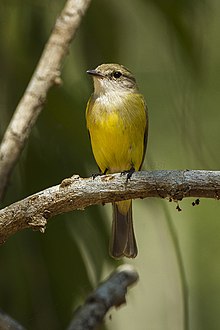Lemon-bellied flyrobin
| Lemon-bellied flyrobin | |
|---|---|

| |
| Scientific classification | |
| Domain: | Eukaryota |
| Kingdom: | Animalia |
| Phylum: | Chordata |
| Class: | Aves |
| Order: | Passeriformes |
| Family: | Petroicidae |
| Genus: | Microeca |
| Species: | M. flavigaster
|
| Binomial name | |
| Microeca flavigaster Gould, 1843
| |
| Synonyms | |
| |
The lemon-bellied flyrobin or lemon-bellied flycatcher (Microeca flavigaster) is a species of bird in the family Petroicidae. Found in Australia, Indonesia, and Papua New Guinea, its natural habitats are subtropical or tropical moist lowland forests and subtropical or tropical mangrove forests.
Taxonomy
[edit]John Gould described the species in 1843 from a specimen from Port Essington in the Northern Territory.[2] The species name is from the Latin word flavus meaning 'yellow', and Ancient Greek gaster meaning 'belly'.[3] Four subspecies are recognised: the nominate flavigaster is found across the top of the Northern Territory, subspecies flavissima in Cape York and New Guinea, subspecies laetissima along the central-northern Queensland coast, and subspecies tormenti in the Kimberley of northwestern Australia.[4] The two Queensland subspecies are separated by the Atherton Tableland and Burdekin-Lynd Divide, and are possibly kept apart by a population of the jacky winter (Microeca fascinans) that replaces it in some areas.[5] Genetic analysis shows that the two Queensland subspecies are very closely related, but that there is quite a large separation from subspecies flavigaster. Subspecies tormenti was not sampled in that study.[6]
Subspecies tormenti, known as the Kimberley flyrobin, was considered a separate species for many years. It is unusual in that it lacks the yellow pigmentation of the other subspecies.[4] Les Christidis and Walter Boles reclassified it as a subspecies, since hybrids between subspecies tormenti and flavigaster have been found in the vicinity of Cambridge Gulf—between the ranges of the two subspecies.[7][8]
As well as lemon-bellied flyrobin, the species is also commonly known as lemon-breasted flycatcher (from when belly was thought crude), yellow-bellied flycatcher, yellow-breasted flycatcher, or brown-tailed flycatcher (subspecies tormenti).[3]
Description
[edit]The adult lemon-bellied flyrobin is around 11.5 centimetres (4.5 in) long.[9] The sexes have similar plumage. The nominate subspecies flavigaster has lemon yellow underparts, a white throat, grey face with a white eyebrow stripe, and olive-brown upperparts. Subspecies tormenti has white underparts, more greyish upperparts, has a longer bill and tail and is larger overall. Subspecies flavissima resembles flavigaster but has a more obvious yellow tinge to the upperparts, throat, yellow eyebrow and a shorter tail, while laetissima more closely resembles flavigaster, but has a shorter tail and bill and is larger overall.[4]
Distribution and habitat
[edit]The species ranges from the Ord River in the west to coastal Queensland, and is found in mangroves, paperbark swamp forests, and woodland.[9]
Feeding
[edit]The lemon-bellied flyrobin is an insectivore, hunting its prey in the foliage or dead branches of trees and shrubs and only rarely on the ground.[10] Fieldwork in Kakadu National Park found that it occasionally caught large insects over 2 centimetres (0.79 in) in length; insects were generally caught by the bird hawking or sallying.[10]
Breeding
[edit]Breeding throughout its range, the lemon-bellied flyrobin breeds from August to February, raising one or two broods a season. The nest is a small dish-shaped structure made of bark and grasses in the fork of a tree. A single egg measuring 19 by 14 millimetres (0.75 by 0.55 in) is laid, pale blue with brownish markings.[11]
References
[edit]- ^ BirdLife International (2017). "Microeca flavigaster". IUCN Red List of Threatened Species. 2017: e.T103736933A118827297. doi:10.2305/IUCN.UK.2017-3.RLTS.T103736933A118827297.en. Retrieved 15 November 2021.
- ^ Gould, John (1843). "In Proceedings of meeting of Zoological Society of London". Proceedings of Meeting of Zoological Society of London. 10: 131–40 [132–33].
- ^ a b Gray, Jeannie; Fraser, Ian (2013). Australian Bird Names: A Complete Guide. Csiro Publishing. pp. 255–56. ISBN 978-0-643-10471-6.
- ^ a b c Schodde, Richard; Mason, I.J. (1999). The Directory of Australian Birds : Passerines. A Taxonomic and Zoogeographic Atlas of the Biodiversity of Birds in Australia and its Territories. Collingwood, Australia: CSIRO Publishing. pp. 375–77. ISBN 9780643102934.
- ^ Ford, Hugh A. (1986). "Avian Hybridization and Allopatry in the Region of the Einasleigh Uplands and Burdekin-Lynd Divide, North-eastern Queensland". Emu. 86 (2): 87–110. doi:10.1071/MU9860087.
- ^ Christidis, L; Irestedt, M; Rowe, D; Boles, W E & Norman, J A (2011). "Mitochondrial and nuclear DNA phylogenies reveal a complex evolutionary history in the Australasian robins (Passeriformes: Petroicidae)" (PDF). Molecular Phylogenetics and Evolution. 61 (3): 726–38. doi:10.1016/j.ympev.2011.08.014. PMID 21867765.
- ^ Christidis, Leslie; Boles, Walter (2008). The Taxonomy and Species of Birds of Australia and its Territories. Royal Australasian Ornithologists Union. p. 202. ISBN 978-0-643065-11-6.
- ^ Johnstone, R.E. "Intergradation between Lemon-breasted Flycatcher Microeca flavigaster Gould and Brown-tailed Flycatcher Microeca tormenti Mathews in Cambridge Gulf, Western Australia" (PDF). Records of the Western Australian Museum. 11 (3): 291–95.
- ^ a b Slater, Peter (1974). A Field Guide to Australian Birds: Passerines. Adelaide: Rigby. p. 167. ISBN 0-85179-813-6.
- ^ a b Brooker, M.G.; Braithwaite, R.W.; Estbergs, J.A. (1990). "Foraging Ecology of Some Insectivorous and Nectarivorous Species of Birds in Forests and Woodlands of the Wet-Dry Tropics of Australia". Emu. 90 (4): 215–30. doi:10.1071/MU9900215.
- ^ Beruldsen, Gordon (2003). Australian Birds: Their Nests and Eggs. Kenmore Hills, Qld: self. p. 338. ISBN 0-646-42798-9.

